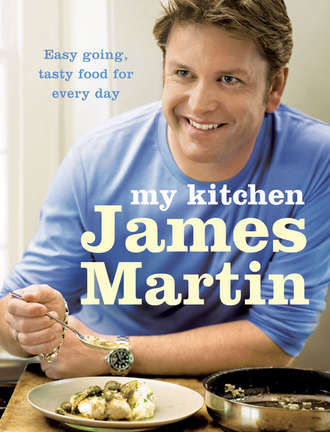
Полная версия
My Kitchen
Thinly slice the rhubarb lengthways and cut into very fine sticks, the size of matchsticks. Place in a bowl of iced water and leave for 20 minutes.
Place the pickled ginger and juice in a bowl, add the lime zest and juice along with the olive oil, then season, to taste, with salt and pepper.
Remove the rhubarb from the iced water, mix into the bowl with the dressing and stir in the chives. Slice up the salmon and arrange on a board or platter, or divide between plates. Serve with the rhubarb salad, some lemon wedges to squeeze over the salmon, and chunks of crusty bread on the side.
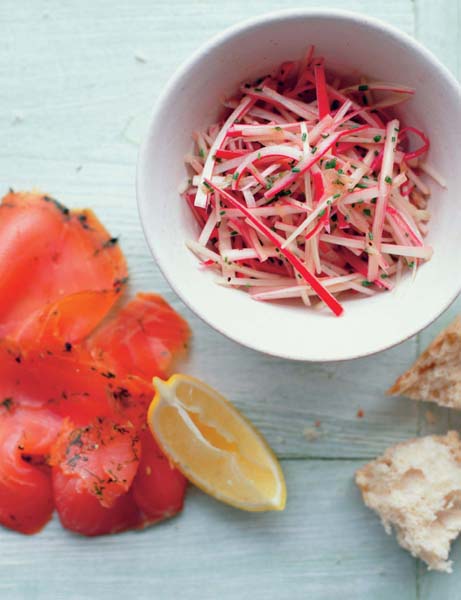
Grilled halibut with champ and lemon caper butter
Serves 4
500g (1lb 2oz) floury potatoes, peeled and cut into quarters
110ml (4fl oz) milk
50g (2oz) butter
150g (5oz) spring onions, chopped
4 × 150g (5oz) halibut fillets, all bones removed
1 tbsp olive oil
110g (4oz) caper berries or capers
Peeled segments of 4 lemons, plus the juice of 1 lemon
1 tbsp chopped flat-leaf parsley
Salt and black pepper
Halibut is a meaty fish, full of flavour and with very few bones. If you can’t get caper berries, use small capers (caper buds) instead, but if they’re in salt or brine, rinse well in hot water before using.
Put the potatoes in a large saucepan, cover with water and add a good pinch of salt. Bring to the boil and cook for 20–25 minutes, then drain the potatoes and return to the pan, which should no longer be over the heat.
Pour the milk into a small saucepan and heat until nearly boiling. Crush the potatoes with a fork or potato masher until they form a chunky mash, then slowly add the hot milk, stirring all the time.
Melt half the butter in a frying pan over a medium heat, tip in the spring onions and sauté for about 2 minutes. Add these to the mash, then season well with salt and pepper and set aside.
Season the halibut with salt and pepper and drizzle with olive oil. Place in a non-stick frying pan over a high heat and cook for 3–4 minutes on each side, or until the fish starts to turn golden-brown. Remove from the heat and set aside.
Add the remaining butter to a medium-sized saucepan set over a high heat. When it has turned nut brown in colour, add the caper berries and the juice of one lemon. Season, then remove from the heat and add the lemon segments and parsley.
Place some champ on each plate with a piece of halibut at the side. Spoon the lemon caper butter over the top and serve.
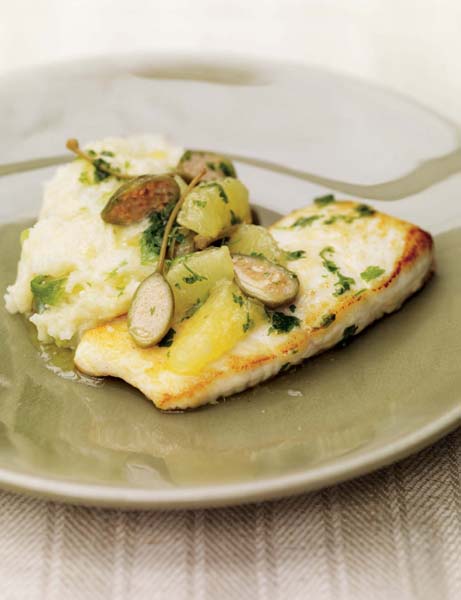
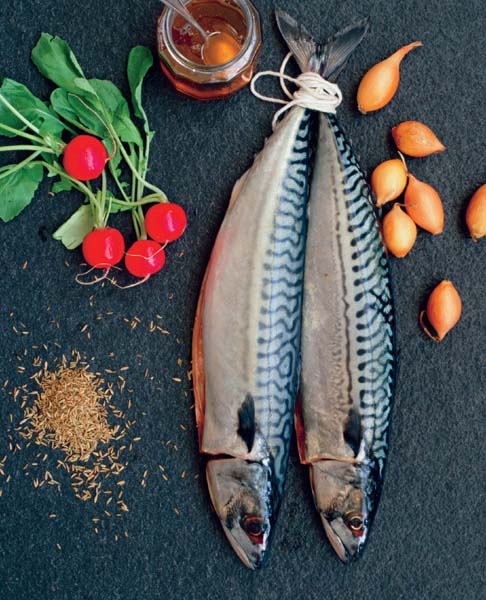
Mackerel with caramelised radishes
Serves 4
16 baby white onions, peeled and left whole
16 radishes
1 tbsp runny honey
2 tsp cumin seeds
4 mackerel, gutted and washed
2 banana shallots, peeled and sliced
2 lemons, sliced
1 bunch of coriander
1 bunch of chives
½ bunch of thyme
50ml (2fl oz) olive oil
This recipe was inspired by a trip to France, where I visited a great market right on the seafront. The fishing boats were moored up alongside the market stalls, which were laden with fresh fish – in particular, mackerel, which is unbeatable when eaten fresh and cooked simply. I was also impressed by the crisp, vibrant radishes on sale. Here I’ve found a way to combine the two.
Place the onions and 110ml (4fl oz) water in a large non-stick saucepan. Bring to the boil and allow to cook for 5 minutes, or until tender, then add the radishes and cook for a further 2–3 minutes.
Add the honey and cumin seeds and cook for a further 5–6 minutes. The colour of the radishes will gradually start to run and form a glaze. When nearly all the liquid has evaporated, remove the pan from the heat.
Preheat the oven to 180°C (350°F), Gas 4. To prepare the mackerel, place 4 sheets of foil on a work surface – each sheet about the size of a newspaper. Divide the shallots, lemons and herbs between the pieces of foil, placing a pile in the middle of each sheet. Place the mackerel on top and score the fish with a sharp knife. Drizzle with the olive oil and a tablespoon of water and fold the foil over to form small parcels.
Place the parcels on a baking tray, put in the oven and cook for about 8–10 minutes. Remove from the oven, open up the parcels and transfer the fish to plates. Gently reheat the onion and radish mix, divide between the plates and serve.
Cod with clams, curly kale and wild garlic
Serves 4
4 tbsp rapeseed or extra-virgin olive oil
150g (5oz) butter
4 × 150g (5oz) cod fillets, skin on
400g (14oz) small, fresh clams, in shells
2 shallots, peeled and finely chopped
200ml (7fl oz) perry (cider-like drink made from pears) or cider
225g (8oz) curly kale, stalks discarded
110g (4oz) wild garlic leaves, or 110g (4oz) fresh spinach and 2 cloves of garlic, peeled and chopped
Zest of 1 lemon
3 tsp finely chopped chives
Salt and black pepper
When buying cod, go for thicker fillets from larger fish, as these have the best flavour and don’t break up too much during cooking. Wild garlic can be found in woodland and by the side of the road; the leaves should be picked before the heads flower. If you can’t find it, use spinach and chopped cloves of garlic instead.
Preheat the oven to 190°C (375°F), Gas 5. Set an ovenproof pan or roasting tin on the hob over a high heat and, when the pan is hot, add the rapeseed or olive oil and 25g (1oz) butter. When the butter has melted, fry the cod fillets for 2–3 minutes on each side, until they are golden-brown all over.
Transfer the pan to the oven and roast the fish for 5 minutes until just cooked through. Remove the pan from the oven, cover with foil and set aside to rest.
Meanwhile, put the clams in a colander and wash thoroughly under running water, discarding any with broken shells or those that don’t close when they are tapped against the side of the colander.
Set a large saucepan over a high heat and, when hot, add the clams, shallots and most of the perry or cider. Lower the heat and simmer, uncovered, for 2–3 minutes, until the clams have opened and the liquid has slightly reduced.
Clean out the colander and place it over a similar-sized bowl. Pour the clams and cooking liquid into the colander so that the liquid drains through to the bowl. Return the liquid to the pan and set the clams aside. Discard any which haven’t opened during cooking.
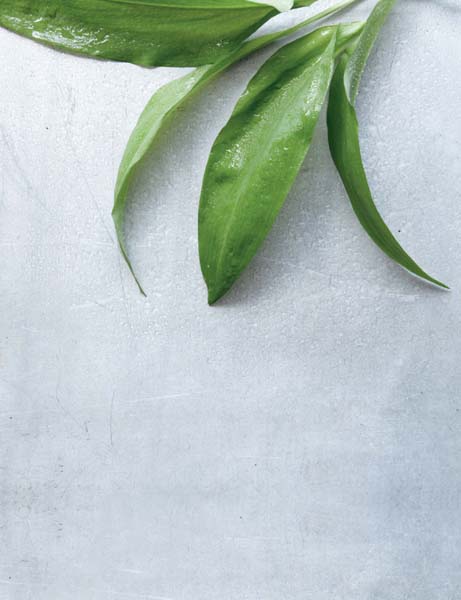
Bring the liquid to the boil and cook until reduced and thickened. To finish the sauce, add half of the remaining butter to the pan and whisk to combine. Season with salt and pepper and then keep it warm until you are ready to serve the dish.
Bring a large saucepan of salted water to the boil and add the curly kale. Cook for 2–3 minutes until just tender. Drain the kale well and place in a frying pan. Add the remaining butter, wild garlic leaves (or spinach and garlic) and lemon zest, and cook over a medium–high heat for just 20 seconds, to wilt the wild garlic. Season with salt and pepper, to taste.
To serve, divide the kale and wild garlic leaves between plates and place the cod on top. Add the final splash of perry and the chives to the clam sauce. Then spoon some of the mixture over the cod and arrange the clams on top. Pour the remaining sauce over the fish and clams, and serve.
Trout with green beans and almonds
Serves 4
4 fresh trout, gutted but with the heads left on
150g (5oz) butter, melted
75g (3oz) whole, shelled almonds
300g (11oz) French beans, topped and tailed
Salt and black pepper
With trendy new varieties of fish arriving from all over the world, we tend to forget how good our own locally-sourced species can be. Trout is a prime example – it’s available all year round and, served with almonds, it’s a classic fish dish.
Place each trout on its back and open up the ribcage with a knife. Using sharp kitchen scissors, cut the backbone in two places – at the highest point near the head and the lowest point by the tail. If you prefer, you can ask your fishmonger to do this for you.
Preheat the oven to 200°C (400°F), Gas 6. Brush each fish, inside and out, with half the butter and season with salt and pepper. Butter a roasting tin and place the fish in the tin, pressing each one down with its ribcage pointing up.
Bake in the oven for 6 minutes and then add the almonds to the tin. Cook for a further 5–6 minutes, then remove from the oven. You can tell when the fish is cooked when you can pull out the backbone easily. Do this for all four fish.
While the fish is cooking, bring a saucepan of salted water to the boil, add the beans and cook for 4–5 minutes, or until just tender. Drain the beans and place in a warmed bowl.
Place the fish on plates and add the remaining butter to the hot roasting tin. Remove the almonds from the tin and add to the beans. Season well with salt and pepper. To serve, place the beans and almonds into the cavity of each trout and spoon over the hot butter from the tin.
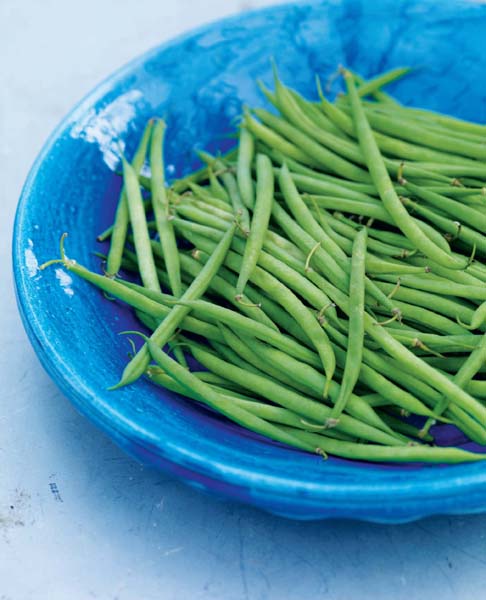
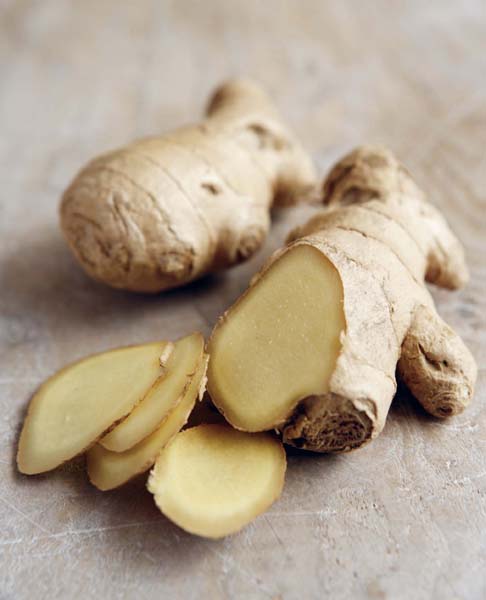
Wok-fried chicken with ginger, chilli and wild garlic
Serves 4
4 × 175g (6oz) boneless, skinless chicken breasts
4 tbsp cornflour
1 tbsp corn oil
2 tbsp finely chopped root ginger
6 spring onions, sliced on the diagonal into 2cm (¾in) pieces
1 red chilli, finely chopped
2 bunches of wild garlic leaves or 225g bag of baby spinach
1 clove of garlic, peeled and chopped
4 tbsp dark soy sauce
Salt
Steamed rice, to serve
The chicken in this recipe is coated in cornflour and poached in water, a cooking method known as ‘velveting’. Pork can be done in the same way. It’s great for a stir-fry, in which the meat is cooked quite quickly, because it really does help to give it a softer texture.
Place a large wok or non-stick frying pan and a large saucepan of salted water on the hob, both set over a high heat. While they are heating, slice the chicken breasts thinly.
Coat the chicken pieces in the cornflour, then place in the water, once it has come to the boil, and blanch for 2 minutes. Remove the chicken from the water and set aside.
Add the corn oil to the wok or frying pan, followed by the chicken, ginger, spring onions and chilli, mixing well together. Cook for 1 minute, then add the remaining ingredients and season with a pinch of salt. Cook for about 1 minute, or until the wild garlic or spinach leaves wilt down.
Serve in bowls with helpings of steamed rice.
Sautéed chicken livers and mushrooms on toast
Serves 4
4 slices from a white bloomer
30g (1¼oz) butter
6 rashers of back bacon, cut into lardons
400g (14oz) chicken livers
200g (7oz) brown cap mushrooms, cut in half
50ml (2fl oz) white wine
110ml (4fl oz) double cream
3 tbsp chopped flat-leaf parsley
Salt and black pepper
Chicken livers are one of the few remaining inexpensive meats and we should use them in cooking a lot more than we do. Make sure the green parts of the livers are removed and don’t overcook them or they will become bitter-tasting and grainy. Mushrooms and double cream make this dish smooth and rich, a perfect opposite to the crunchy toast.
Toast the bread either in a toaster or under the grill, preheated to medium–high, and set aside.
Melt half the butter in a frying pan set over a high heat, add the bacon and fry until it starts to crisp. Add the livers and mushrooms and saute for 1 minute.
Pour over the wine and cream and stir all the ingredients together for 2–3 minutes, but no more, to ensure the livers stay pink in the middle, then remove the pan from the heat.
Add the parsley and season with salt and pepper. Serve with slices of toast, plain or buttered with the remaining butter.
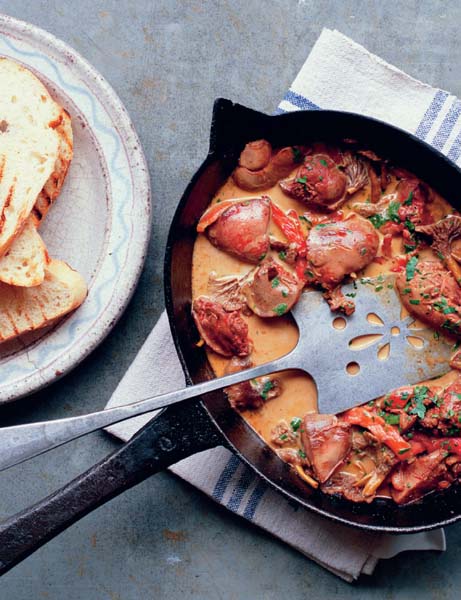
Rack of lamb with vegetable broth
Serves 4
20g (¾oz) shelled hazelnuts
4 large, floury potatoes, peeled and quartered
4 racks of Frenchtrimmed lamb (ask your butcher to prepare these)
1 tbsp olive oil
12 baby onions, peeled but left whole
800ml (29fl oz) beef stock
200g (7oz) broad beans
250g (9oz) asparagus tips
110g (4oz) French beans, topped and tailed
40g (1½oz) butter
110ml (4fl oz) double cream
2 tbsp chopped flatleaf parsley
4 tsp hazelnut oil (optional)
Salt and black pepper
My favourite lamb supplier is Colin Robinson, a family butcher from Skipton, North Yorkshire. If you’re in the area, pay him a visit. I promise you won’t be disappointed.
Preheat the oven to 200°C (400°F), Gas 6. Roast the hazelnuts on a baking tray for 15–20 minutes, or until the skins split. Take out of the oven, tip into a clean tea towel and rub to remove the skins. Once cooled, chop the nuts in half.
Place the potatoes and a good pinch of salt in a large saucepan of water. Bring to the boil and cook for 20–25 minutes.
Season the lamb with salt and pepper. Put the olive oil in a roasting tin, place over a high heat and add the lamb. Seal on all sides, especially the side with the fat. Add the onions to the tin and put in the oven for 6 minutes. Remove from the oven, add the hazelnuts and return to the oven for 6 minutes more.
Pour the stock into another large saucepan, bring to the boil and reduce by half. Add the broad beans, cook for 3–4 minutes, then remove them (reserving the stock) and refresh in cold water. Peel off the skins. Just before the lamb is ready, add the asparagus tips and French beans to the stock to cook. Remove the lamb from the oven and allow to rest in the tin. Meanwhile, drain the potatoes, return to the pan and mash with butter and cream. Add salt and pepper and keep warm.
Drain the fat from the lamb and add the hazelnuts and onions to the stock. Return the peeled broad beans, add the parsley, and season with salt and pepper. Slice each rack of lamb in half and place with the mash in the centre of bowls. Spoon the broth around and drizzle with hazelnut oil, if you wish.
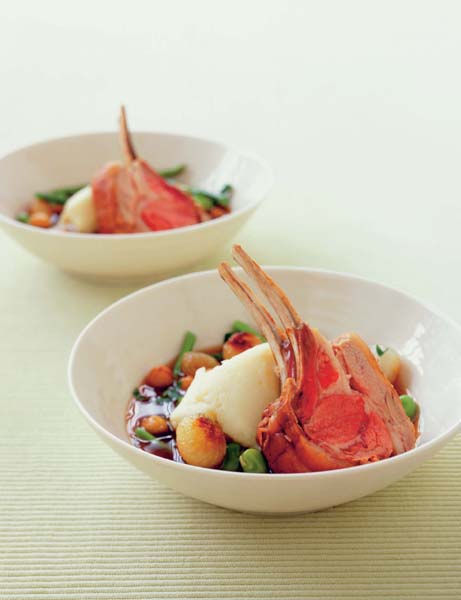
Lamb, mint and Little Gem salad
Serves 4
2 racks of lamb, bones removed (ask your butcher to do this)
1 tbsp olive oil
3 sprigs of rosemary
50g (2oz) butter, cut into cubes
2 Little Gem lettuces
Salt and black pepper
For the dressing
1 tsp caster sugar
25ml (1fl oz) Chardonnay vinegar or other white wine vinegar
75ml (3fl oz) extra-virgin olive oil
1 tbsp chopped mint
Salt and black pepper
This simple and delicious salad can be eaten hot, warm or even cold, whichever way you prefer. It reminds me of my gran – like me, she loved fresh mint in salads or eaten with lamb. So, Gran, this recipe is in memory of you.
Preheat the oven to 200°C (400°F), Gas 6.
Trim the lamb, removing excess fat if you wish, and, using a piece of string, tie up into a tight roll. Season with salt and pepper.
Set an ovenproof pan or roasting tin over a high heat, add the tablespoon of olive oil and then the lamb, turning it in the pan for 2–3 minutes to seal on all sides, so that it is an even golden colour. Add the rosemary and the butter and remove the pan from the heat.
Roast in the oven for 8 minutes, basting from time to time with the butter, then remove from the oven. When the lamb has cooled slightly, remove from the pan, wrap in cling film tightly with the rosemary and set aside on a chopping board.
Place the sugar and the vinegar in a bowl, mix well then add the extra-virgin olive oil and the mint. Season with salt and pepper, to taste, stir together and pour into a serving jug.
Place the leaves from the lettuces in a serving bowl. Remove the lamb from the cling film, slice very thinly and serve with the salad leaves and the jug of dressing on the side.
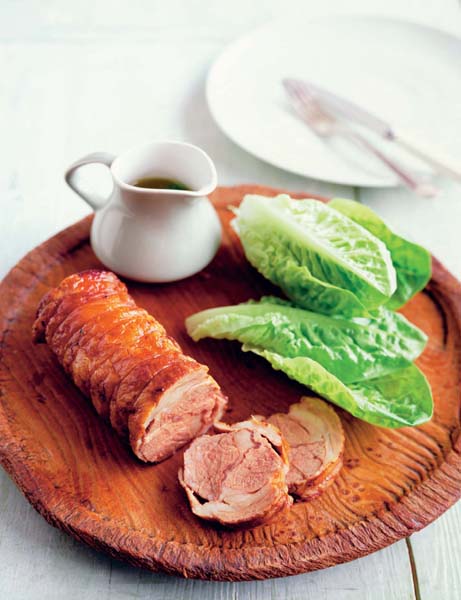
Côte de boeuf with watercress and black beer mustard
Makes 2 large portions or 4 smaller ones
1kg (2lb 2oz) rib of beef with the chine bone removed (ask your butcher to do this for you)
2 tbsp olive oil
Salt and black pepper
110g (4oz) Black Beer Mustard (see page 36), to serve
For the watercress salad
1 tbsp cider vinegar
3 tbsp rapeseed or extra-virgin olive oil
1 tsp Black Beer Mustard (see page 36)
110–150g (4–5oz) watercress, thick stalks removed
Salt and black pepper
Côte de boeuf is a large cut of beef with a big, thick rib bone. If you can’t get it, use a thick rib-eye steak instead. This is equally delicious cooked on a barbecue in summer for 10 – 15 minutes on each side.
Season the beef with salt and pepper and brush with the olive oil. Set a frying pan over a high heat and, when it starts to smoke, add the beef and cook for 4–5 minutes on one side, then turn over and cook for a further 4–5 minutes. Turn the beef to seal the edges and cook for a further 4 minutes on each side, or 8–10 minutes per side if you prefer your meat well done.
Remove the beef from the pan, place on a chopping board and allow to rest for 5 minutes before carving.
To make the watercress salad, whisk the vinegar, rapeseed or olive oil and mustard together in a bowl and season to taste with salt and pepper. Place the watercress in another bowl and drizzle over the dressing, tossing the leaves to coat evenly. Place in a serving bowl and set aside.
To serve, cut the beef into fairly thick slices and serve the mustard and the watercress on the side.
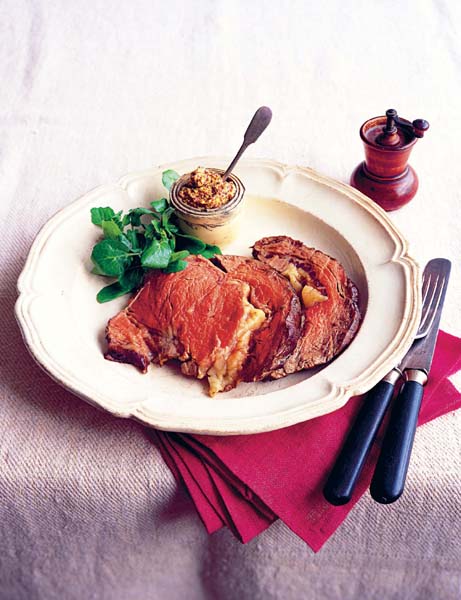
Black beer mustard
Makes 425g (15oz)
Vegetarian
25g (1oz) white mustard seeds
110g (4oz) black mustard seeds
75g (3oz) light soft brown sugar
1 tsp allspice berries
1 tsp paprika
½ tsp turmeric
2 tsp sea salt
1 tsp crushed black peppercorns
175ml (6fl oz) red wine vinegar
40ml (1½fl oz) balsamic vinegar
3 tbsp runny honey
110ml (4fl oz) bottled Black Sheep Ale or other traditionally-made British beer
Mustard is very easy to make and handy to keep in your store cupboard. It goes well with many types of meat – try it with the Yorkshire ham on page 39.
Put all the dry ingredients into a food processor or blender and blend until the seeds are roughly crushed. Transfer to a bowl and stir in the two vinegars, honey and ale.
Cover the mustard with cling film and place in the fridge for 2 hours. If you want to keep the mustard longer, put into sterilised jars (see page 166) and store in a cool, dark place. The mustard should then keep for 3–6 months.






